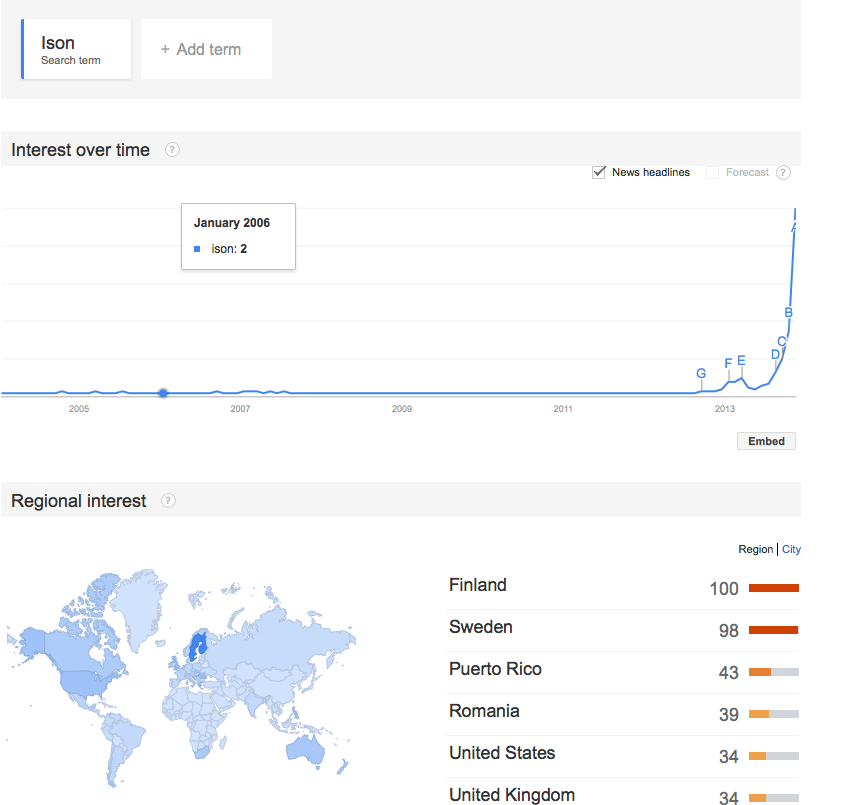
November 29, 2013, by Brigitte Nerlich
Is Ison (still) on?
Over the last weeks there has been much talk about a comet called Ison. As Wikipedia tells us “C/2012 S1, also known as Comet ISON or Comet Nevski–Novichonok, is a sungrazing comet discovered on 21 September 2012 by Vitali Nevski (Виталий Невский, Vitebsk, Belarus) and Artyom Novichonok (Артём Новичонок, Kondopoga, Russia).
It attracted quite a lot of media coverage and some hype: “After it was discovered in 2012, some media sources called C/2012 S1 the ‘Comet of the Century’ and speculated that the comet might outshine the full Moon. An Astronomy Now columnist wrote in September 2012 that ‘if predictions hold true then C/2012 S1 will certainly be one of the greatest comets in human history.’ … a Daily Mail columnist described C/2012 S1 as ‘the Comet of the Century’ and said it was ‘hoped to be 15 times brighter than the Moon.’ Astronomer Karl Battams criticized the media’s suggestion that the comet would be ‘brighter than the full Moon’, saying that members of the Comet ISON Observing Campaign did not foresee ISON becoming that bright.” (Wikipedia)
Ison was supposed to be visible at the beginning of December if it survived a ‘close encounter’ with the sun. Here is a model simulation of its trajectory. Unfortunately, on 28 November we learned that, like Icarus, Ison had flown too close to the sun and might not have survived or might only have survived in bits….or might have survived (see NASA image here).
Every time I phoned my parents in Germany (who have become sort of vicarious science enthusiasts in their old age) during the last couple of weeks, they told me the latest story about Ison and asked me whether I was aware of the comet’s vicissitudes. When I said I wasn’t, I was told to pay a bit more attention, as I was supposed to be interested in science after all. This was quite sweet – sort of Ison the soap-opera. And of course they expected me to look out of the window at the beginning of December to catch a glimpse of it.
Ison took on a real personality for a very short but exciting time. It experienced what one might call a meteoric rise to celebrity status. People seemed to root for it, especially at the moment I was writing this post (28 November). It also became a bit of a comic comet. Tweets and headlines punned: now you see it, now you don’t, Zombie comet, coming back from the dead, Schrödinger’s comet – there was a lot of fun to be had. As Michael Brooks asked in New Statesman: Who’d be a comet in this era of rolling news coverage and internet commentary? I can’t resist quoting the last paragraph of this article: “Ison’s final indignity will come thanks to the many scientific instruments in space; there is no danger of the comet escaping unpapped. This week its fate will be caught by no fewer than eight space-based cameras. Out there, no one can hear you scream, but everyone can see you burn bright – or fall apart.”
On the day of its apparent disappearance and disintegration (28 November), there were 1010 articles about its fate available on Google news. And it seems not only the media and my parents were cheering it on, so were quite a few other people across the globe, in particular, it seems in Finland, according to Google trends.
There is, of course, also a lot of chatter on twitter. Pallab Ghosh tweeted: #Ison: “Reports of my death have been greatly exaggerated”
Some of the headlines about this astronomical event convey the excitement of this celestial adventure – and the following selection starts with the current end of the story (28 November):
Comet ISON perhaps NOT GARBAGE after all – glows … –
Schrödinger’s Comet’ ISON LIVES (or DOESN’T) after Thanksgiving solar roast
‘Zombie’ comet ISON may be back from the dead
Ison: Critical time for ‘comet of the century’
Comet Ison Fragment ‘May Have Survived’
Hope still for ‘dead’ Comet Ison
COMET ISON’s sun dive climax: RENDEZVOUS with DESTINY
Comet Ison: Blow for stargazers as ‘comet of the century’ destroyed …
Good luck ISON! Astronomers hope ‘comet of the century’ will …
Comet Ison set for close encounter with the sun
I am still not sure whether I or my parents will ever see Ison, but it it’s fun while it lasts. Events like this, which may be astronomically far away, or perhaps because they are so far away, make science close and personal, or at least have the potential to do so. They are ideal for engaging the public without arousing the fear and distrust that some close encounters with science now regularly entail. Let’s enjoy the moment! Go Ison go!
And for some more fun and some more science read this article in New Scientist… (added on 29th November)
Image: Wikimedia Commons


[…] just have to click through to see what that means!], on kickstarters, on 4D printing, on the Zombie comet Ison, on science, politics and certainty and why scientists may be reluctant to join the game of giving […]
[…] once blogged about the much more ephemeral comet Ison and the way it took on a personality for a short time. So I wanted to see what people said about […]
[…] read a fascinating article on comets in the history of art. This would be a nice topic for another blog post… but that’s not what this post is about. When looking at these delightful pictures, my eyes […]